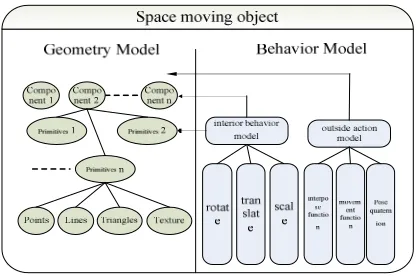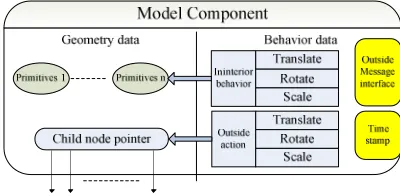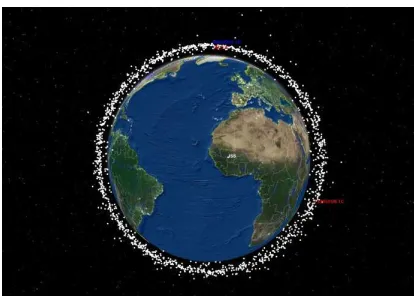MODELING AND VISUALIZATION OF SPACE OBJECTS
SPATIO-TEMPORAL DATA
Xu Qing, Zhou Yang, Zhang Baoming, Lan ChaoZhen
Institute of Surveying and Mapping, ZhengZhou 450052, China
Zhouyang3d@163.com
Commission V, WG V4
KEY WORDS: Visualization, 3D Modeling, spatio-temporal data, Moving Object, primitives
ABSTRACT:
In future, 3 Dimensions Geographic information System (3D GIS) should support the temporal dimensions
modeling and manage all three components efficiently. It is difficult for current 3D Visualization software to deal
with temporal phenomenon. An spatio-temporal data model is proposed in this paper, this data model take
geometry-data, space moving data and inside action data of the object into account comprehensively. And
accomplish holistic modeling of geometry, action, and moving data of the object..
With the increasing of applications need to dispose
moving objects, the conventional DBMS can not fit
the continuous changing data, moving objects
Spatio-temporal Data Model is the key technique of
moving objects Spatio-temporal DBMS, thus, moving
objects Spatio-temporal data modeling became a
popular issue these years.
1. RELATIONAL RESEARCH
Sistla (
Sistla, 1997)
had advanced the conception ofmoving object in 1997, and accomplish the
MOST(Moving Objects Spatio-temporal Data Model).
This model dose not contains the whole history of
moving object and only support query of its’ current
state, so, query at different time receive different
result, base on got knowledge of moving object, we
can query future state of the object, but can not
receive the history data.
Guting(
Guting 1998, Guting 2000)
,Erwig(Erwig
1998,
Erwig 1999)
and Forlizzi(Forlizzi 2000)
,etc research on space moving object modeling, and
Sliced Representation conception is proposed, namely,
use a set of Spatio-temporal units represent the
evolvement of a space moving object.
Hong Yong Wang analyzed space Moving Objects
Spatio-temporal Data Model created by Guting, etc ,
combined with spatio-temporal knowledge and
spatio-temporal extended query experiment, worked
over part of basic method, accomplished history
evolvement of moving object’s in 2D space, query of
space moving object’s state at any time, and so on.
Yan Sheng Lu, etc(Lu
2006)
analyzed the problem ofMOST model and discrete model, and a moving
object Spatio-temporal Data Model, HCFMOST, is
given. This model adopts cubic Hermite polynomial
interpolation to simulate trace of moving object’s
history unit, adopts linear function simulate trace of
moving object’s current unit, and disposed the error of
current unit. This model can query history trace
accurately, query current and future trace with error.
Yong Gao(
Gao 2007)
etc aim at planar movingobjects in 2D Euclidean space, establish
Spatio-temporal Data Model based on time slice.
Defined model of moving objects Spatio-temporal
topology relationship based on points set theory,
expressed by compound of 9 model description,
temporal and spatial topology relationship. At the
same time, advanced Spatio-temporal topology
more, given expression method of moving objects’
dynamic Spatio-temporal character. This model
proposed a expression and calculation method of
moving objects’ Spatio-temporal topology
relationship, express the dynamic character effectively,
provide theory basic for moving objects database and
Spatio-temporal query of it.
Ping Zhan (
Zhan 2007)
etc, concentrate on querytechnique of moving objects’ index method, a
integrated tree, used for restricted moving objects’
index structure, then, used index smoothness achieve
query of future moment.
Spatio-temporal Data of moving objects is
multidimensional, the information changed with time
is 3+1dimensional (3D space and time), if take pose
and other information into account, the dimension
increase. The correlative researches mentioned above
aim at moving objects, namely, the space position of
objects changed with time, but not consider change of
pose and inner attributes. With the change of positions
of space moving object, it’s pose data and inner
attributes changed too, so, design of Spatio-temporal
Data Model of space moving object is complex.
2 DATA TYPE OF SPACE MOVING OBJECT Data types chiefly include basic type, temporal and
example, moving act on point, generate moving point
type “mpoint”; intime act on point generate
definition”, into the value domain.
(2) Temporal type
data types chiefly include point, line, and region.
Owing to any spatial entity can described by number
represent a set of numerable points; Lines represent a
set of numerable continuous lines in planar; Triangle
represents triangle, Meta represents basic metafile
combined by numerable Triangle. Classification of
metafile will mention next section.
Figure 1. Classification of Spatial data
>
(4) Moving data type
Moving type(
Guting 2000)
,is a mapping from timeto another type, the value represents the changing
function with time of another type. For example,
describe a continuous moving point in space, we need
position sequence
{ }
3
R
p
k⊆
to time sequence
{ }
t
R
k
⊆
. If the trace of the point
is a simple curve (a curve has no crossing, and the end
is outside the curve, it can be ring), the mapping from
1 D space (time) to 3D space
{ } { }
continuous, the mapping can transform
to
f
:
DA
instant→
DA
point, this mapping calledHere, αincludes all the data type and space type, e.g.
)
To all the
moving
type, for convenience mark andconsistent to correspond type, we use follow method
identify
moving
type: add a prefixion “M”before parameter type, e.g. Mpoint,Mpoints,Mline,
Mtriangle,Mint,Mstring and Mboolean. Take Mpoint
for example, explain the data structure.
>
=<
unit
sum
unit
cur
Trajectory
Mpo
int
::
_
,
_
,
>
=<
unit
unit
unit
nTrajectory
::
1,
2,
,
function or hermite interpolation function to simulate
the trace of moving object.
(5)Range data type
For all moving type, should has correspond operate to
mapping, aim at return a range of domain. For
domain) ,mapping can be compactly expressed as set
of interval within the 1D domain. In practice, we
interest in interval of real number and integer, we can
receive
range
(
α
)
by a typeconstructor
range
.α
is basic type or time type.Take
Interval
for example:i
T
and
T
i+1 are start and end moment respectively.3 SPACE MOVING OBJECT SPATIO-TEMPORAL DATA MODEL
Literature (
Ye 2004)
classify describe method ofmoving object into two kinds:
(1) Describe methods based on moving function
Describe spatial state and moving state of moving
object with function, generally, moving function is
function of time, giving a time within definition
domain, corresponding state data can be calculated.
(2) Describe methods based on state swatch
This method describes the whole process of
movement by a series of discrete state swatch,
evidently, it is a kind of simulate and approximate
method.
Excellent Space Moving Objects model should take
various conditions into account, make proper choice
as different condition, In other words, it should
support function method and swatch method
simultaneously, so that it can be used to manage
moving objects under control by simulation system
and securable object got by moving function, as well
as un-securable ones.
Space objects circulate in space include natural
planets, automobiles, airplanes, ships, satellites and
space scrap, and so on. These moving objects moving
within it’s own orbit. Not only the position and rate
vector, but also include pose and inside state data
changing with time. Inside state data include shift,
rotate, scale of inside components and change of using
state caused by kinds of reasons.
Aimed at the character of space moving object, the
paper design a Space Moving Objects
Spatio-Temporal model, this data model take
geometry-data, space moving data and inside action
data of the object comprehensively, space moving
data include position, speed and pose data, the
compute method of data can choose between orbit
kinetic function and interpose function base on
practical needed precision, can describe movement
state of space object.
As figure 2 shows, structure of Spatio-Temporal data
of space moving object make up of geometry model
and action model chiefly. ① Geometry model
describes the geometry shape of object, can be made
up of several basic primitives, every primitives makes
up of several Points, Lines, Triangles, and Textures.
②Action model includes inside action model and outside action model. Inside action model describes
action between components inside space objects (such
as solar board, point of sensor and action of
machine arm of detector and so on), so Inside action
model acts on components or basic primitives of
geometry, which cause the inside action. Outside
action model describes space object as whole move
state, which can obtain by interpose function and orbit
kinetic function.
Figure 2. Space moving object Spatio-Temporal data
structure
(1) outside action model of Space moving object
Moving trace of Space moving object can be obtained
by orbit kinetic function with a series of time interval,
these positions called sampling points.To describe
moving state of space object within period of time,
theoretically, we need infinite points, but is
irrealizable and not necessary in discrete model
created by computer. For discrete data model, we can
only increase sampling points to describe continuous
moving attribute more accurately, but due to large
amount of space moving objects and complexity of
calculate of orbit dynamics function, compute burden
of system increasing enormously. In fact, changing of
space objects within a period is continuous, that can
reduce sampling calculation by appropriate
interpolation function.
The position and velocity vector at sampling points of
provided by Space track Report No:3, according to
practical requirement of precision. SGP、SGP4 and
SGP8 are suit for near-earth satellite, and SDP4 and
SDP8 are suit for deep-space satellite.
With these sampling points, the pose, position, and
rate vector of Space moving object can obtained by
interpolation function. Guting’s discrete model adopts
linear interpolation function simulate moving trace of
moving object between sampling points, but in
practice, moving trace of moving object generally is
not line, when required precision is high, linear
interpolation function is not efficiency. So, against
history moving trace, SMOST model adopts cube
Hermite polynomial interpolation function to simulate,
consequently, make simulation of moving object’s
historic moving trace more precise,and reduce the
error.
Every sampling point of DSMOST model, not only
include position, but also velocity (includes value and
direction). Suppose that, two neighboring sampling
points are
(
T
i,
P
i,
V
i)
and(
T
i+1,
P
i+1,
V
i+1)
, Tmeans time, P means position(x, y, z) ;V means
velocity. Suppose cube Hermite polynomial
interpolation function on
[
T T
,
i+1]
is:Replace element of formula (7)with formula (8), there
is:
Prevenient space moving object Spatio-Temporal
Modeling mainly research one dimensional or two
dimensional moving object, so most of these do not
take pose data into account. But in three dimensional
space, for non-linear moving object, especially
satellite, pose data is one of significant attribute,
generally a important factor to judge whether the state
of moving object is normal, thus, pose data is an
indispensable factor of expression of moving object.
This paper adopts quaternion to describe the outside
pose of moving object.
(2) Interior action model of Space moving object
Most of Space moving object have interior action are
manual objects, such as remote sensing satellite,
automobile, airplane, ship, and so on. They are
generally make up of kinds of complicated
components, some of the components can act under
specific conditions, we called these behavior inside
action of space object, such as open of solar board,
uncover of the sensor, turning of the cartwheel of
moon . In order to describe the complicated interior
action data of complicated object, we design a
integrated modeling method of geometry and action.
A geometry model can be constitutive of some basic
primitives no matter how complicate it is, so we create
some basic primitives. Firstly, all of them can describe
by parameter, which means the geometry shape, color
and transparency can be modified by parameters. This
paper define 12 primitives (see table 1), which
include two classes: one is basic primitives; the other
dynamic supplement which mainly accomplish
complicated special effect.
Name signification
basic primitives
Cylinder Cylinder Extrusion Extrusion
Sphere Sphere
Polygon Space Polygon PolygonMesh Polygon Mesh
Revolve Revolve
Skin Skin(grid face)
Helix Helix
extend primitives
TextureSmoke Smoke effect ParticleSystem ParticleSystem
LodMesh Lod grid
Billboard Billboard Primitives
…… ……
Table 1 Class of primitives
Description of geometry Primitives is flexible, we can
define different object by set different parameters of
same primitives. Take Cylinder for example, it can
build Cylinder, taper, prism, pyramid, and so on..
In order to combine these basic primitives into
complicated space object, this paper design a tree
structure to describe complicated space object, shows
as figure 3.
Figure 3 Tree structure of complicated moving object
Node of the tree is called model component,
component include action and geometry data, based
on different effect domain, action data include local
action data and extended action data. Local action
data include basic primitives act on this component,
extended action data act on son component pointed by
this component. Model component include a extended
interface message, which used to trigger inside action
by outside message. Time tag triggers action by time.
Sketch map of model component are as follows.
Figure 4. Sketch map of model component
4 TEST RESULT
This paper describe space moving object by MOST
Spatio-Temporal data model, these objects include
natural planet, manual satellite, moving object on
ground, and so on. The visualized result of space
moving object Spatio-Temporal data model , is
showed as figure 5. And this model has been used in
many projects.
Figure 5a. Modeling and Visualization of planets of
solar system
Figure 5b. Modeling and Visualization of deep space
Figure 5c. Modeling and Visualization of geometry
and interior action of deep space detector
Figure 5d. Modeling and Visualization of space
scrap running within orbit
Figure 5. Modeling and Visualization of space moving
objects
Because this data model take both the describe
methods base on moving function and state swatch
into account, so it can extend conveniently to suit the
describe of object near-earth, even on the ground.
(Figure 6)
Figure 6a. moving object on the sea
Figure 6b. moving object on ground
Figure 6. Modeling and Visualization of moving
objects on earth
References from Journals:
Guting R H, Michael H, Bohlen,Martin Erwig, etal.
2000. Foundation for representing and querying
moving objects. ACM Transactions on Database
Systems, , 25(1), pp. 1-42
Lu Yansheng, Cha Zhiyong, Pan Peng, 2006. An
improve queed spatio-temporal data model for moving
objects, Journal of HuaZhong University of Science
and Technology(Nature Science), 34(8), pp.32-35
Gao Yong, Zhang Jing, Zhu Xiaoxi, Liu Yu, 2007.
Spatio-Temporal Topological Relation Modeling of
Moving Objects, ACTA Scientiarum Naturalium
Universitatis Pekinensis, 43(4), pp. 468-473
Zhan Ping, Guo Jing, Guo Wei, 2007. Query
processing about near future position of moving
objects based on spatio-temporal index structure,
Journal of WuHan University(ENGINEERING),
40(3), pp. 103-108
Guting R H, Michael H, Bohlen,Martin Erwig, etal.
2000. Foundation for representing and querying
moving objects. ACM Transactions on Database
Systems, 25(1), pp. 1-42
References from Other Literature:
Sistla,A.P., O.Wolfson, S.Chamberlain, and S.Dao,
1997. Modeling and Querying Moving Objects. In
Proceedings of the 13th International Conf. On Data
Guting, R.H., Bölhen,M.H., Erwig,M., Jensen, C.S.,
Lorentzos,N.A., Sehneider,M. and Vazirgiarinis M.,
1998. A Foundation for Representing and Querying
Moving Objeets[R].Technieal Report informatik238,
fern University Hagen
Erwig,M. R.H.Guting, M. Sehneider, and
M.Vazirgiaxinis, 1998. Abstract and Discrete
Modeling of spatio-Temporal Data Types[C]. In
Proc.of the 6th ACM Symp. On Geographic
Information Systems, Washington, D.C., pp.
131-136
Erwig,M. Sehneider, M. 1999. Developments in
Spatio-temporal Query Languages[C]. In IEEE
Int.Workshop on Spatio-Temporal Data Models and
Languages(STDMT) Florence, Italy, pp. 441-449
Forlizzi, L., Guting, R.H., Nardelli, E. and Sehneider,
M., 2000. A Data Model and Strueture for Moving
Objects Databases[C]. In Proc. ACM SIGMOD
Intl.Conf. On Management of Data, pp. 319-330



